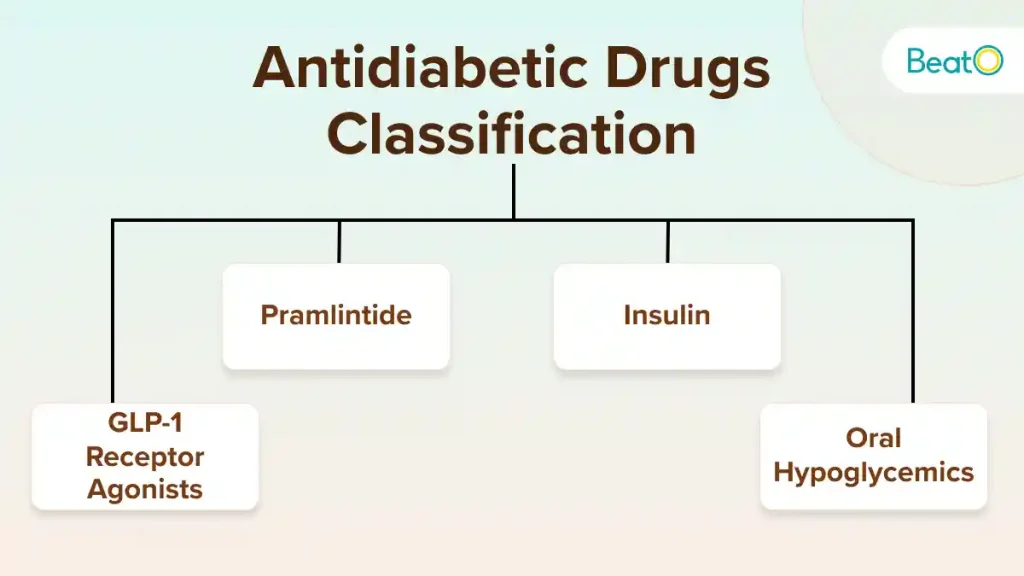Diabetes mellitus is a chronic condition characterised by increased blood glucose levels. It occurs when the body is unable to produce (Type 1 diabetes) or utilise insulin (Type 2 diabetes). However, managing diabetes can be challenging and requires combined approaches such as lifestyle modifications, medications, dietary changes, and monitoring blood glucose levels. Moreover, antidiabetic drugs are a class of drugs that help regulate blood glucose levels. The main goal of the anti-diabetic drug is to manage insulin & regulate the blood glucose levels.

Also read: 7 Incredible Tamarind Benefits For Blood Sugar Regulation & Overall Health
Antidiabetic Drugs Classification
Did you know that anti-diabetic drugs offer a variety of solutions to individuals with diabetes? Here are some names of anti-diabetic drugs.

1. Pramlintide
It is an injectable drug replicating the effects of amylin, a hormone released with insulin. These hormones manage glucose levels by reducing the pace at which food is absorbed and digested in the body. But the question is, how does Pramlintide work? It decreases glucagon secretion and slows down the stomach processes by emptying it, increasing satiety, and eventually improving blood glucose management.
2. Insulin
Insulin is a hormone that is essential to allow glucose in the blood to enter cells and is produced by the pancreas. But what is its role in diabetics? Diabetic’s bodies either fail to produce enough insulin or don’t use it adequately. Insulin therapy is a critical component of diabetes management and can be provided by injections or insulin pumps. Here are the primary forms of insulin.
- Long-Acting Insulin: This form of insulin offers a consistent release of insulin over an extended period of time. It is commonly used as basal insulin. This form of insulin reduces blood glucose levels for up to 24 hours or more, gradually affecting the bloodstream. Examples include insulin glargine, insulin degludec (Tresiba), and insulin detemir (Levemir).
- Short-Acting Insulin: This kind of insulin drug is usually administered before meals to control blood sugar levels during the meal. It starts functioning in around 30 minutes, peaks after 2-3 hours, and lasts 3-6 hours. For example, Novolin R FlexPen, Humulin R, and Novolin R ReliOn.
- Rapid-Acting Insulin: This type is used prior to or following meals to prevent post-meal glucose rises. It starts working within 15 minutes, reaches its peak 1-2 hours later, and lasts 2-4 hours. For example, insulin lispro (Admelog, Humalog), insulin aspart (Fiasp, NovoLog), inhaled insulin (Afrezza), & insulin glulisine (Apidra).
- Intermediate-Acting Insulin: This form of insulin has a less rapid start and a longer duration of action, resulting in basal insulin coverage. It begins to work 2-4 hours after usage, reaches its peak after around 12 hours, and lasts for 12-18 hours. Examples may include insulin isophane (Humulin N, Novolin N).
3. GLP-1 Receptor Agonists
This class of anti-diabetic drugs is referred to as Glucagon-like peptide-1 (GLP-1) receptor agonists. These injectable drugs imitate the effects of the natural GLP-1 hormone. They increase insulin secretion, suppress glucagon release, and slow stomach emptying.
4. Oral Hypoglycemics
Oral hypoglycemics, commonly known as oral antidiabetic drugs, are a group of drugs that are used for managing blood sugar levels in people with type 2 diabetes.
| Class of Drug | Mechanism of Action |
|---|---|
| Metformin | It limits glucose synthesis in the liver and increases insulin sensitivity. |
| Sulfonylureas | Stimulate the pancreas to produce more insulin, which helps manage blood glucose levels. |
| DPP-4 Inhibitors | Inhibit the enzyme dipeptidyl peptidase-4, thereby extending the activity of incretin hormones that increase insulin secretion. |
| SGLT-2 Inhibitors | Prevent glucose reabsorption in the kidneys, resulting in higher glucose excretion in urine. |
| Thiazolidinediones (TZDs) | Improve insulin sensitivity in cells, hence increasing glucose uptake |
| Alpha-Glucosidase Inhibitors | Delay carbohydrate digestion and absorption, which helps to manage post-meal glucose levels. |
Antidiabetic Drugs for Type 1 Diabetes
In individuals with type 1 diabetes, the body is unable to produce insulin on its own. So, the purpose of anti-diabetic drugs is to replace the insulin your pancreas cannot produce. Let’s look at the fundamentals of insulin and how pramlintide, an amylinomimetic, fits into the equation.
1. Pramlintide
Pramlintide, an amylinomimetic injectable, is administered before meals. It reduces the time it takes your stomach to empty after eating. Next, it lowers the hormone glucagon after meals, which aids in blood sugar regulation and can also suppress the appetite.
2. Insulin
Insulin Pump: A small programmable device that delivers specified insulin doses throughout the day through a catheter and tube or a tubeless pump pod.
Injections require a fine needle and syringe or an insulin pen, and a combination of insulin types is possible.
Anti-Diabetic Drug List for Type 2 Diabetes
Here is the list of Antidiabetic drugs for type 2 diabetes that you must prefer if you have type 2 diabetes.
1. Biguanides
- Example: Metformin
- Mechanism: Reduces hepatic glucose production and increases insulin sensitivity in peripheral tissues.
- Primary Use: Type 2 Diabetes Mellitus (T2DM)
2. Sulfonylureas
- Examples: Glipizide, Glyburide, Glimepiride
- Mechanism: Stimulates insulin release from pancreatic beta cells.
- Primary Use: T2DM
3. Meglitinides (Glinides)
- Examples: Repaglinide, Nateglinide
- Mechanism: Stimulates rapid, short-acting insulin secretion from the pancreas.
- Primary Use: T2DM
4. Thiazolidinediones (TZDs)
- Examples: Pioglitazone, Rosiglitazone
- Mechanism: Increases insulin sensitivity in muscle and adipose tissue by activating PPAR-gamma.
- Primary Use: T2DM
5. Alpha-glucosidase Inhibitors
- Examples: Acarbose, Miglitol
- Mechanism: Delays carbohydrate absorption in the intestines by inhibiting alpha-glucosidase enzymes.
- Primary Use: T2DM
6. Dipeptidyl Peptidase-4 (DPP-4) Inhibitors
- Examples: Sitagliptin, Saxagliptin, Linagliptin
- Mechanism: Inhibits DPP-4 enzyme, increasing levels of incretin hormones, which increases insulin secretion and decreases glucagon levels.
- Primary Use: T2DM
7. Glucagon-like Peptide-1 (GLP-1) Receptor Agonists
- Examples: Exenatide, Liraglutide, Semaglutide
- Mechanism: Mimics GLP-1, enhancing glucose-dependent insulin secretion, suppressing glucagon secretion, and slowing gastric emptying.
- Primary Use: T2DM
8. Sodium-Glucose Co-Transporter 2 (SGLT2) Inhibitors
- Examples: Canagliflozin, Dapagliflozin, Empagliflozin
- Mechanism: Inhibits SGLT2 in the kidneys, reducing glucose reabsorption and increasing glucose excretion in urine.
- Primary Use: T2DM
Also read:15 Benefits of Eating Raw Onion You Must Know About
9. Amylin Analogs
- Example: Pramlintide
- Mechanism: Slows gastric emptying, reduces postprandial glucagon secretion, and promotes satiety.
- Primary Use: T1DM and T2DM
10. Dopamine-2 Agonists
- Example: Bromocriptine
- Mechanism: Modulates hypothalamic regulation of metabolism, increasing insulin sensitivity.
- Primary Use: T2DM
Also read: 12 Best Fat Burning Foods To Help You Lose Weight
Oral Antidiabetic Drugs/Antidiabetic Drugs Chart
Here is a table summarising the oral hypoglycemic tablets along with their names and their mechanism for managing diabetes.
| Class | Medication Example | Mechanism of Action |
|---|---|---|
| Biguanides | Metformin | Reduces glucose production by the liver and improves insulin sensitivity. |
| Sulfonylureas | Glipizide, Glyburide | Stimulate the pancreas to release more insulin, aiding in blood glucose control. |
| DPP-4 Inhibitors | Sitagliptin, Saxagliptin | Inhibit the enzyme dipeptidyl peptidase-4, prolonging the action of incretin hormones, which stimulate insulin release. |
| SGLT-2 Inhibitors | Canagliflozin, Dapagliflozin | Prevent the reabsorption of glucose in the kidneys, leading to increased glucose excretion in urine. |
| Thiazolidinediones (TZDs) | Pioglitazone, Rosiglitazone | Improve insulin sensitivity in cells, enhancing glucose uptake. |
| Alpha-Glucosidase Inhibitors | Acarbose, Miglitol | Slow down the digestion and absorption of carbohydrates, helping to control post-meal glucose levels. |
Also read: 7 Strawberry Benefits You Need To Know
Final Words
Managing diabetes requires a multidimensional approach that involves lifestyle changes, dietary changes, regular monitoring, and the proper use of antidiabetic drugs. Awareness of the various antidiabetic drug classes and mechanisms can assist healthcare providers in adjusting treatment programs to patients’ specific needs, enhancing their quality of life and lowering the risk of long-term consequences. Always remember, before making any sort of changes in your diabetes management regimen, always check with a healthcare professional.
Disclaimer: The content of this article is compiled information from generic and public sources. It is in no way a substitute, suggestion, or advice for a qualified medical opinion. Always consult a specialist or your own doctor for more information. Beato App does not claim responsibility for this information.
Are you looking for the perfect glucometer to check your blood sugar level? Try out BeatO smartglucometerkit, affordable and easy to use.
Discover top-tier diabetes care with BeatO’s Chief Clinical Officer,Dr. Navneet Agarwal. His expertise in Diabetes ensures personalised guidance for overall health. Try out a smartglucometerand keep track of blood sugar levels now.




